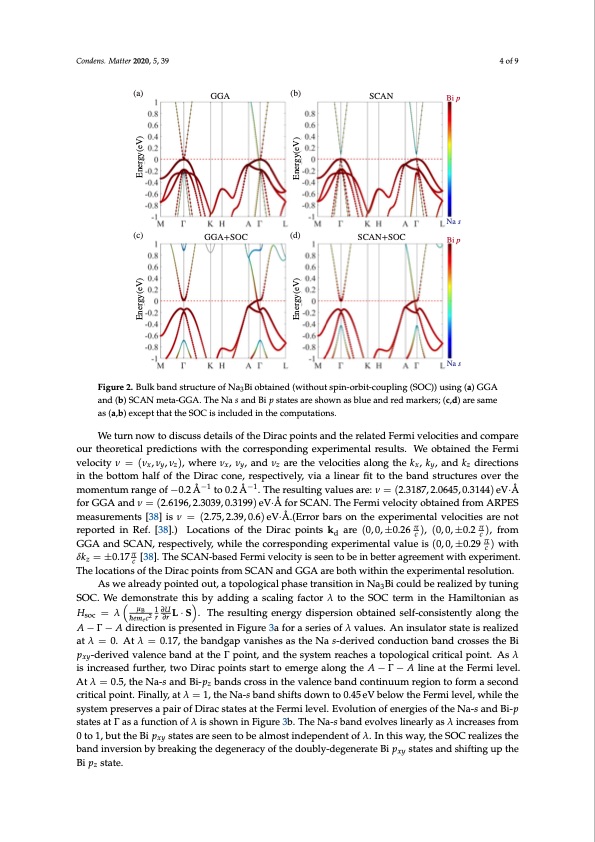
PDF Publication Title:
Text from PDF Page: 004
Condens. Matter 2020, 5, 39 4 of 9 (a) (c) GGA (b) SCAN Bi p Na s Bi p Na s GGA+SOC (d) SCAN+SOC Figure 2. Bulk band structure of Na3Bi obtained (without spin-orbit-coupling (SOC)) using (a) GGA and (b) SCAN meta-GGA. The Na s and Bi p states are shown as blue and red markers; (c,d) are same as (a,b) except that the SOC is included in the computations. We turn now to discuss details of the Dirac points and the related Fermi velocities and compare our theoretical predictions with the corresponding experimental results. We obtained the Fermi velocity ν = (νx,νy,νz), where νx, νy, and νz are the velocities along the kx, ky, and kz directions in the bottom half of the Dirac cone, respectively, via a linear fit to the band structures over the momentum range of −0.2 Å−1 to 0.2 Å−1. The resulting values are: ν = (2.3187, 2.0645, 0.3144) eV·Å for GGA and ν = (2.6196, 2.3039, 0.3199) eV·Å for SCAN. The Fermi velocity obtained from ARPES measurements [38] is ν = (2.75, 2.39, 0.6) eV·Å.(Error bars on the experimental velocities are not reported in Ref. [38].) Locations of the Dirac points kd are (0, 0, ±0.26 πc ), (0, 0, ±0.2 πc ), from GGA and SCAN, respectively, while the corresponding experimental value is (0, 0, ±0.29 πc ) with δkz = ±0.17 πc [38]. The SCAN-based Fermi velocity is seen to be in better agreement with experiment. The locations of the Dirac points from SCAN and GGA are both within the experimental resolution. As we already pointed out, a topological phase transition in Na3Bi could be realized by tuning SOC. We demonstrate this by adding a scaling factor λ to the SOC term in the Hamiltonian as μB1∂U Hsoc = λ h ̄ eme c2 r ∂r L · S . The resulting energy dispersion obtained self-consistently along the A − Γ − A direction is presented in Figure 3a for a series of λ values. An insulator state is realized at λ = 0. At λ = 0.17, the bandgap vanishes as the Na s-derived conduction band crosses the Bi pxy-derived valence band at the Γ point, and the system reaches a topological critical point. As λ is increased further, two Dirac points start to emerge along the A − Γ − A line at the Fermi level. At λ = 0.5, the Na-s and Bi-pz bands cross in the valence band continuum region to form a second critical point. Finally, at λ = 1, the Na-s band shifts down to 0.45 eV below the Fermi level, while the system preserves a pair of Dirac states at the Fermi level. Evolution of energies of the Na-s and Bi-p states at Γ as a function of λ is shown in Figure 3b. The Na-s band evolves linearly as λ increases from 0 to 1, but the Bi pxy states are seen to be almost independent of λ. In this way, the SOC realizes the band inversion by breaking the degeneracy of the doubly-degenerate Bi pxy states and shifting up the Bi pz state. Energy(eV) Energy(eV) Energy(eV) Energy(eV)PDF Image | Topological Dirac Semimetal Phase in Bismuth Based Anode Materials for Sodium-Ion Batteries

PDF Search Title:
Topological Dirac Semimetal Phase in Bismuth Based Anode Materials for Sodium-Ion BatteriesOriginal File Name Searched:
condensedmatter-05-00039-v3.pdfDIY PDF Search: Google It | Yahoo | Bing
Sulfur Deposition on Carbon Nanofibers using Supercritical CO2 Sulfur Deposition on Carbon Nanofibers using Supercritical CO2. Gamma sulfur also known as mother of pearl sulfur and nacreous sulfur... More Info
CO2 Organic Rankine Cycle Experimenter Platform The supercritical CO2 phase change system is both a heat pump and organic rankine cycle which can be used for those purposes and as a supercritical extractor for advanced subcritical and supercritical extraction technology. Uses include producing nanoparticles, precious metal CO2 extraction, lithium battery recycling, and other applications... More Info
| CONTACT TEL: 608-238-6001 Email: greg@infinityturbine.com | RSS | AMP |